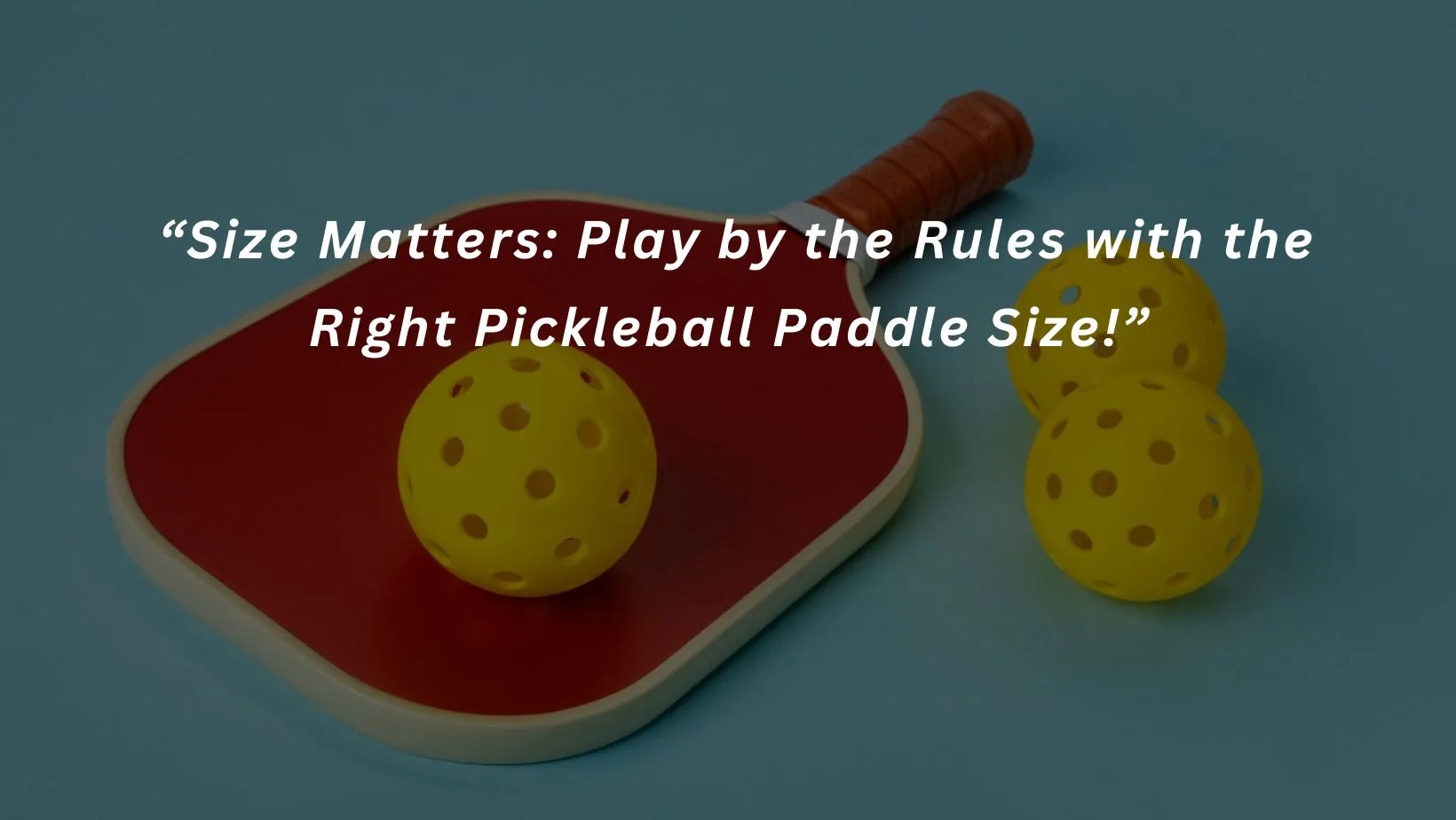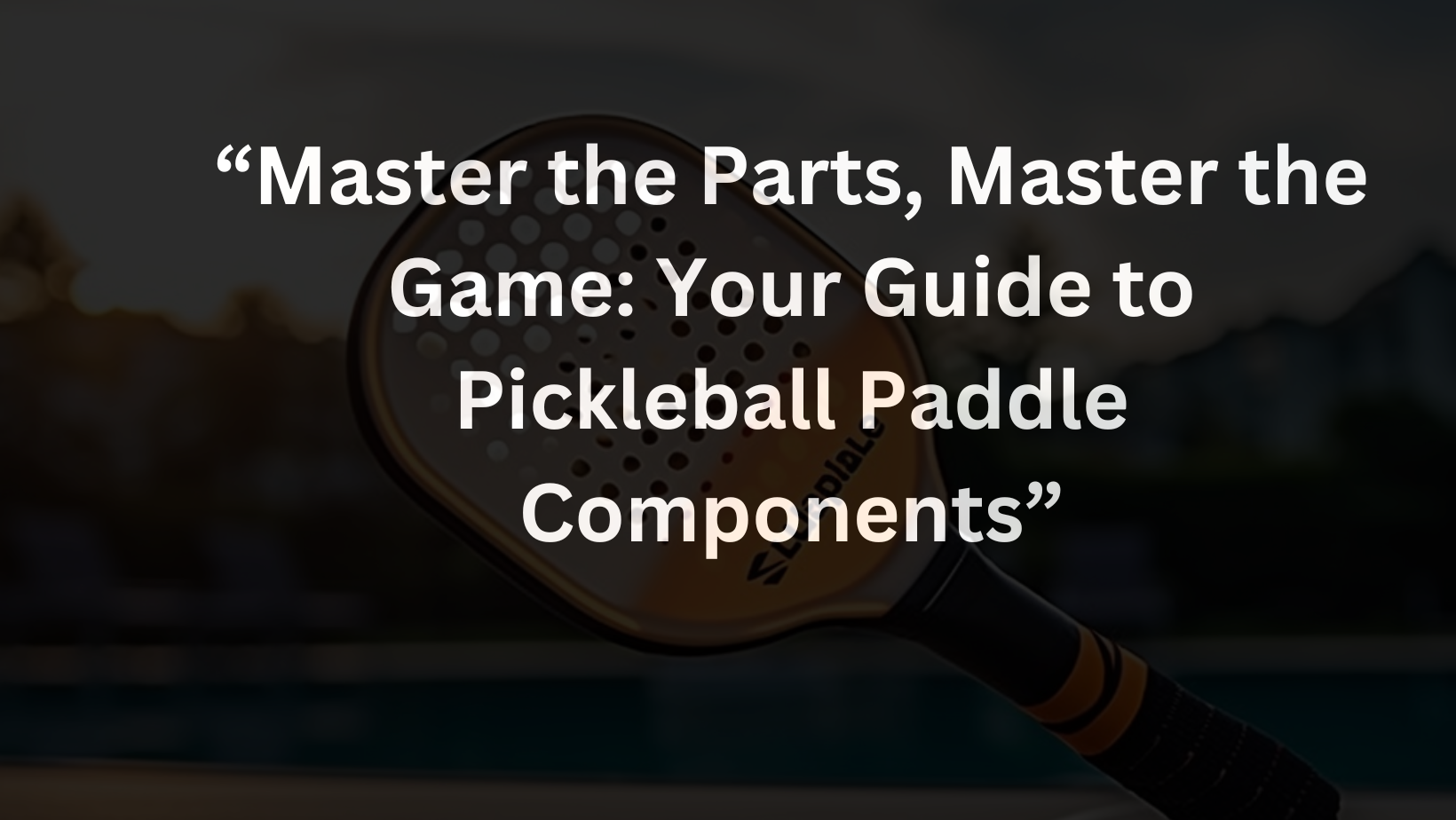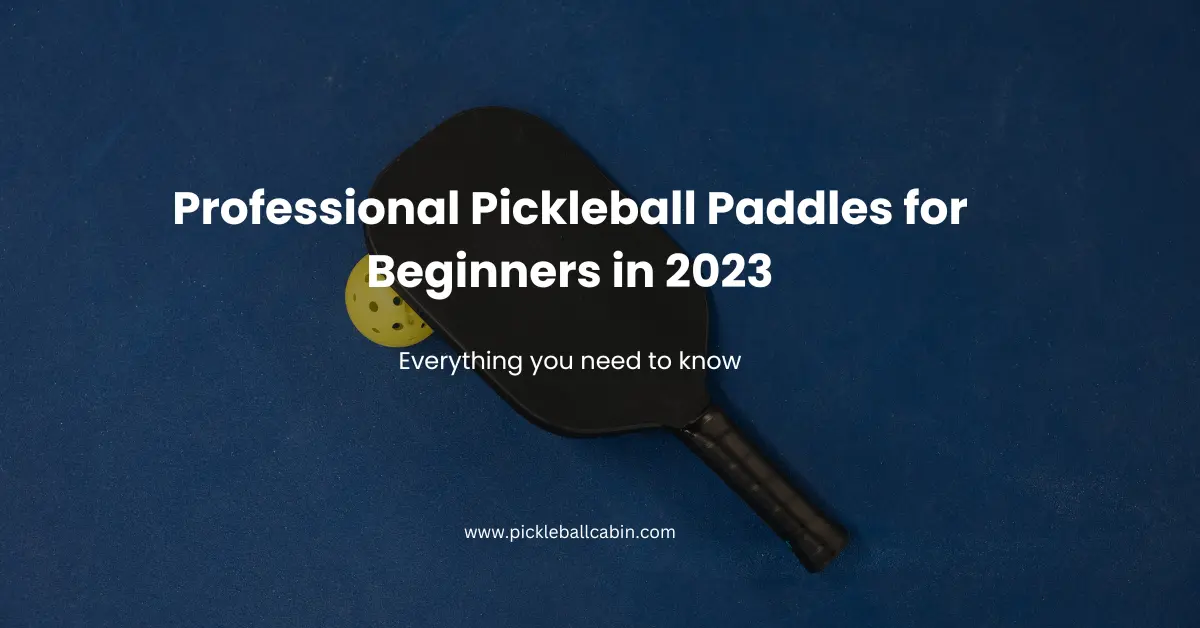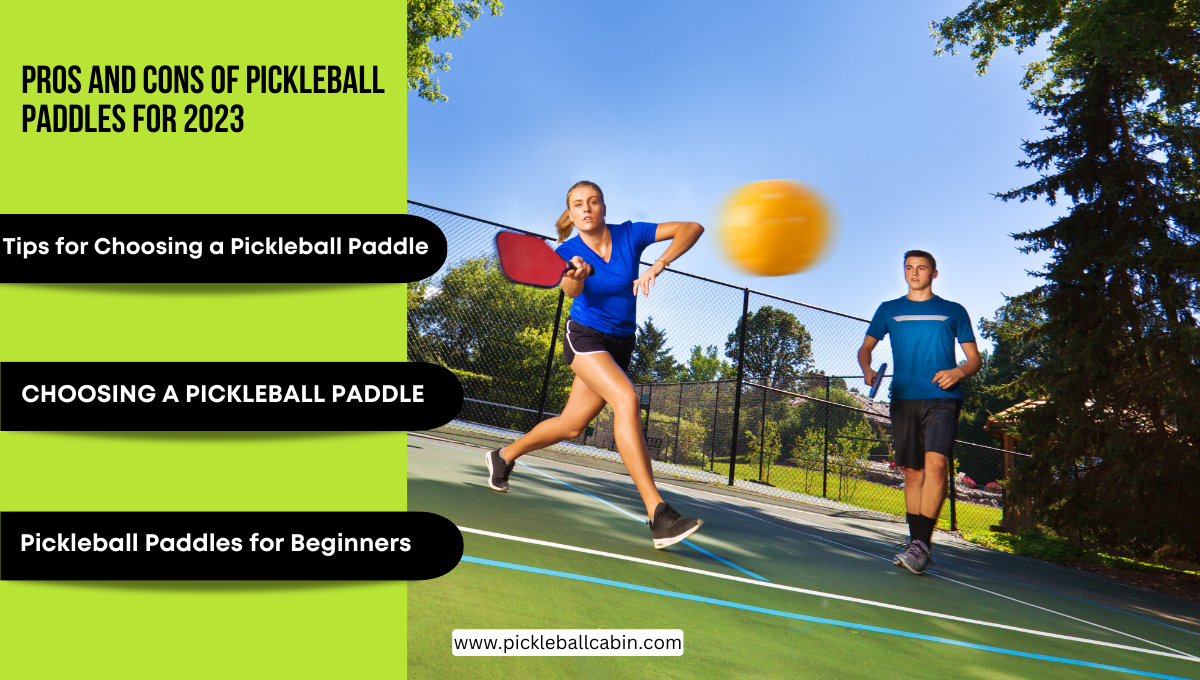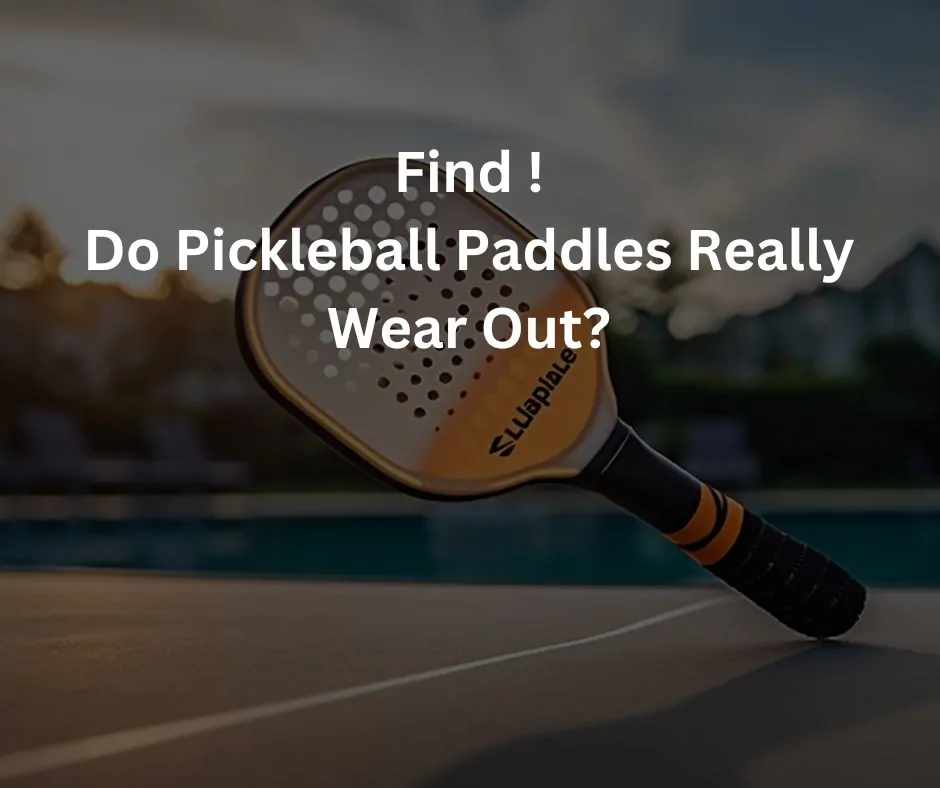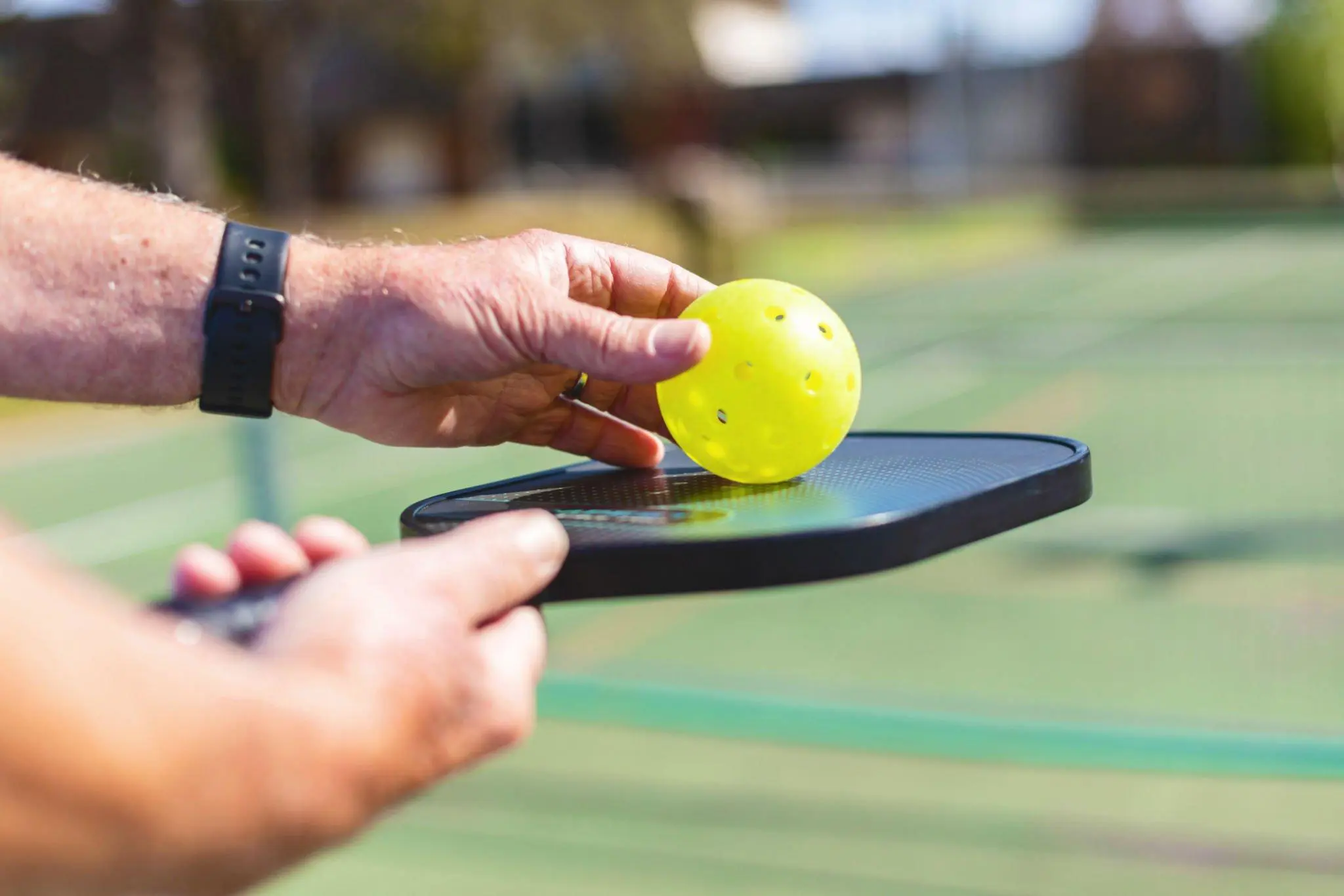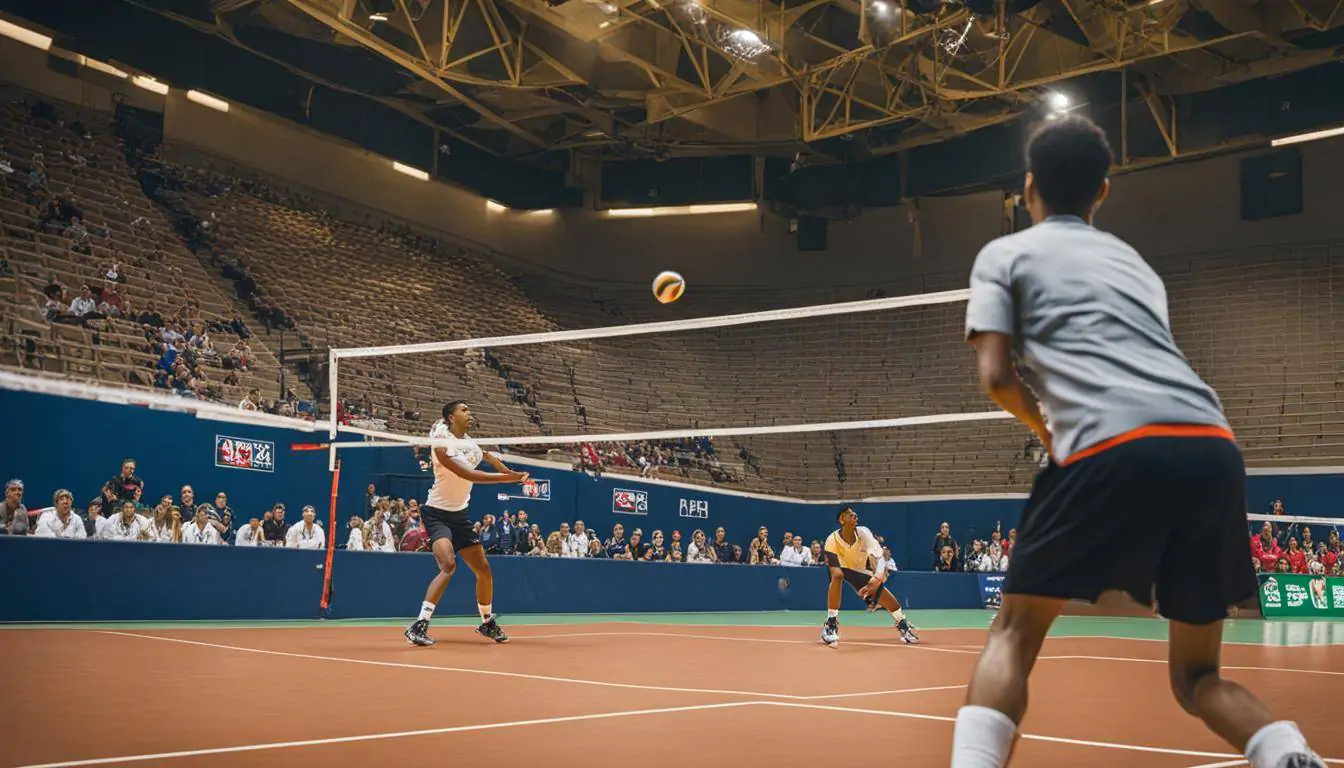Pickleball Paddle Size Regulations
To play pickleball properly, you need to have the right equipment, especially the paddle. The paddle is the most important piece of gear in pickleball, as it affects how you hit the ball, control the direction and speed, and execute different shots. Therefore, it is essential to understand the pickleball paddle size regulations and how they impact your gameplay and performance.
Part 1: Choosing the Right Pickleball Paddle
1.1. Why Your Paddle Choice Matters
Your paddle choice matters because it can make a big difference in your game. A paddle that suits your playing style, skill level, and preferences can help you improve your accuracy, consistency, and confidence on the court. On the other hand, a paddle that is too big, too small, too heavy, or too light can hinder your ability to hit the ball effectively, cause fatigue and injury, and frustrate you. Therefore, you should choose a paddle that fits your hand comfortably, has the right balance of power and control, and complies with the official rules and regulations of pickleball.
1.2. Factors to Consider When Choosing a Pickleball Paddle
There are several factors to consider when choosing a pickleball paddle, such as:
Shape:
The shape of the paddle determines the size of the hitting surface and the sweet spot. The sweet spot is the area of the paddle that produces the best contact and response when hitting the ball. Generally, the larger the hitting surface, the larger the sweet spot. However, a larger paddle also means a larger surface area that can catch the wind and affect your swing. Therefore, you should choose a paddle shape that matches your playing style and skill level. There are two main types of paddle shapes: standard and elongated. Standard paddles have a rectangular shape with a width of about 8 inches and a length of about 15.5 inches. Elongated paddles have a narrower and longer shape with a width of about 7 inches and a length of about 17 inches. Standard paddles are more common and suitable for most players, as they offer a good balance of power and control. Elongated paddles are more specialized and suitable for advanced players, as they offer more reach and maneuverability, but less stability and sweet spot.
Weight:
The weight of the paddle affects the amount of power and control you can generate with your strokes. Generally, the heavier the paddle, the more power you can produce, but the less control you have. The lighter the paddle, the more control you can have, but the less power you generate. Therefore, you should choose a paddle weight that matches your playing style and physical ability. There are three main categories of paddle weights: light, medium, and heavy. Light paddles weigh less than 7.3 ounces, medium paddles weigh between 7.3 and 8.4 ounces, and heavy paddles weigh more than 8.5 ounces. Light paddles are ideal for players who prefer a finesse game, with more touch and feel, and who have good arm strength and speed. Medium paddles are ideal for players who prefer a balanced game, with a combination of power and control, and who have average arm strength and speed. Heavy paddles are ideal for players who prefer a power game, with more force and speed, and who have strong arm strength and endurance.
Face Material:
The face material of the paddle affects the texture and stiffness of the hitting surface. The texture and stiffness of the paddle influence how the ball bounces off the paddle, how much spin you can impart on the ball, and how durable the paddle is. Therefore, you should choose a face material that matches your playing style and preferences. There are four main types of face materials: wood, composite, graphite, and carbon fiber. Wood paddles are the cheapest and heaviest type of paddles, and they have a smooth and hard surface. They are suitable for beginners who want to learn the basics of the game, but they offer less control and durability than other types of paddles. Composite paddles are made of a combination of materials, such as fiberglass, polymer, and aluminum. They are lighter and more durable than wood paddles, and they have a textured and flexible surface. They are suitable for intermediate and advanced players who want a versatile and responsive paddle. Graphite paddles are made of a thin layer of graphite over a honeycomb core. They are the lightest and thinnest type of paddles, and they have a smooth and stiff surface. They are suitable for advanced players who want a fast and precise paddle. Carbon fiber paddles are similar to graphite paddles, but they use carbon fiber instead of graphite. They are slightly heavier and thicker than graphite paddles, and they have a smooth and rigid surface. They are suitable for advanced players who want a powerful and consistent paddle.
Core:
The core of the paddle affects the weight and thickness of the paddle. The weight and thickness of the paddle influence how the paddle feels in your hand, how the paddle absorbs the impact of the ball, and how the paddle transfers the energy to the ball. Therefore, you should choose a core that matches your playing style and preferences. There are three main types of cores: aluminum, Nomex, and polypropylene. Aluminum cores are made of thin sheets of aluminum that form a honeycomb structure. They are the heaviest and thickest type of cores, and they produce a loud and metallic sound when hitting the ball. They are suitable for players who want a solid and durable paddle. Nomex cores are made of a synthetic material that forms a honeycomb structure. They are lighter and thinner than aluminum cores, and they produce a loud and crisp sound when hitting the ball. They are suitable for players who want a stiff and responsive paddle. Polypropylene cores are made of a plastic material that forms a honeycomb structure. They are the lightest and thinnest type of cores, and they produce a soft and quiet sound when hitting the ball. They are suitable for players who want a flexible and forgiving paddle.
FInd More about Core at; Nomex vs Polymer Core
1.3. How to Measure Grip Size for a Pickleball Paddle
The grip size of the paddle affects how comfortable and secure the paddle feels in your hand. The grip size also affects how much wrist action you can use to generate spin and control. Therefore, you should choose a grip size that fits your hand size and playing style. There are four main grip sizes for pickleball paddles: 4 inches, 4.125 inches, 4.25 inches, and 4.5 inches. To measure your grip size, you can use one of the following methods:
- Height Test for Pickleball Grip Size: This method is based on the assumption that your grip size is proportional to your height. To use this method, simply measure your height in inches and divide it by 9. For example, if you are 5 feet 6 inches tall, your height in inches is 66. Divide 66 by 9, and you get 7.33. Round up to the nearest eighth of an inch, and you get 7.375. This means your grip size is 4.375 inches, which is between 4.25 and 4.5 inches. You can choose either one, depending on your preference.
- Finger Length Test for Pickleball Grip Size: This method is based on the assumption that your grip size is proportional to your finger length. To use this method, hold the paddle in your dominant hand with a continental grip, which is the most common grip for pickleball. This means holding the paddle as if you were shaking hands with it, with the base of your palm on the same level as the bottom of the handle. Then, wrap your fingers around the handle and check the space between your palm and your ring finger. If there is no space, your grip size is too small. If there is more than a finger’s width of space, your grip size is too large. Ideally, there should be a slight space, about the width of your index finger, between your palm and your ring finger. This means your grip size is just right.
- Index Finger Test for Pickleball Grip Size: This method is based on the assumption that your grip size is proportional to your index finger width. To use this method, hold the paddle in your dominant hand with a continental grip, as described above. Then, place the index finger of your other hand between the tips of your ring finger and your palm. If your index finger fits snugly, your grip size is just right. If your index finger is too loose or too tight, your grip size is too large or too small, respectively.
- When in Doubt as to Pickleball Grip Size: If you are unsure about your grip size, or if you are between two sizes, it is generally better to choose a smaller grip size than a larger one. This is because a smaller grip size allows you to have more wrist action and control, and you can always increase the grip size by adding an overgrip or a cushion grip. However, a larger grip size can limit your wrist action and control, and you cannot decrease the grip size easily.
1.4. Paddle Materials and Their Impact
The paddle materials and their impact on your game are discussed in detail in the previous section. Here is a summary of the main points:
- Shape: Standard paddles offer a good balance of power and control, while elongated paddles offer more reach and maneuverability, but less stability and sweet spot.
- Weight: Light paddles offer more control and touch, but less power and stability. Medium paddles offer a balanced game, with a combination of power and control. Heavy paddles offer more power and force, but less control and maneuverability.
- Face Material: Wood paddles are cheap and heavy, and they offer less control and durability. Composite paddles are versatile and durable, and they offer a textured and flexible surface. Graphite paddles are fast and precise, and they offer a smooth and stiff surface. Carbon fiber paddles are powerful and consistent, and they offer a smooth and rigid surface.
- Core: Aluminum cores are solid and durable, and they produce a loud and metallic sound. Nomex cores are stiff and responsive, and they produce a loud and crisp sound. Polypropylene cores are flexible and forgiving, and they produce a soft and quiet sound.
Part 2: Pickleball Paddle Regulations Explained
2.1. Approved Dimensions
The dimensions of the paddle are regulated by the USA Pickleball Association (USAPA), which is the governing body of the sport in the United States. The USAPA sets the standards for the equipment, rules, and pickleball tournaments. The USAPA also maintains a list of approved paddles that meet the specifications and pass the tests for compliance. To be approved by the USAPA, a paddle must meet the following dimensions:
- Overall Dimensions: The overall length of the paddle, including the handle and the edge guard, must not exceed 17 inches. The overall width of the paddle, including the edge guard, must not exceed 8.5 inches. The overall thickness of the paddle, including the edge guard, must not exceed 0.75 inches.
- Face Dimensions: The face length of the paddle, excluding the handle and the edge guard, must not exceed 16.5 inches. The face width of the paddle, excluding the edge guard, must not exceed 8.25 inches.
2.2. Grip Size Regulations
The grip size of the paddle is not regulated by the USAPA, as it is a matter of personal preference and comfort. However, the USAPA does provide some guidelines for choosing the right grip size, as discussed in the previous section. The USAPA also recommends that the grip should be securely attached to the handle and should not have any loose or exposed parts that could injure the player or the opponent.
2.3. Weight Regulations
The weight of the paddle is not regulated by the USAPA, as it is a matter of personal preference and playing style. However, the USAPA does provide some guidelines for choosing the right paddle weight, as discussed in the previous section. The USAPA also advises that the weight of the paddle should not exceed the physical ability of the player and should not cause undue fatigue or injury.
2.4. Hitting Surface Characteristics
The hitting surface of the paddle is regulated by the USAPA, as it affects the performance and fairness of the game. The USAPA sets the standards for the materials, texture, and stiffness of the hitting surface. To be approved by the USAPA, a paddle must meet the following characteristics:
- Approved Materials: The hitting surface of the paddle must be made of rigid, non-compressible material that does not impart any additional spin, speed, or deflection to the ball. The hitting surface must not have any holes, indentations, roughness, or tackiness that could alter the flight or bounce of the ball. The hitting surface must not have any features that could provide a mechanical advantage to the player, such as springs, hinges, or magnets. The hitting surface must not have any reflective or distracting properties that could interfere with the vision of the player or the opponent.
- Prohibited Surface Materials: The hitting surface of the paddle must not be made of any material that is banned by the USAPA, such as metal, cork, leather, sandpaper, or rubber. The hitting surface must not be covered with any substance that is prohibited by the USAPA, such as glue, resin, silicone, or tape. The hitting surface must not be modified with any method that is prohibited by the USAPA, such as sanding, scraping, or painting.
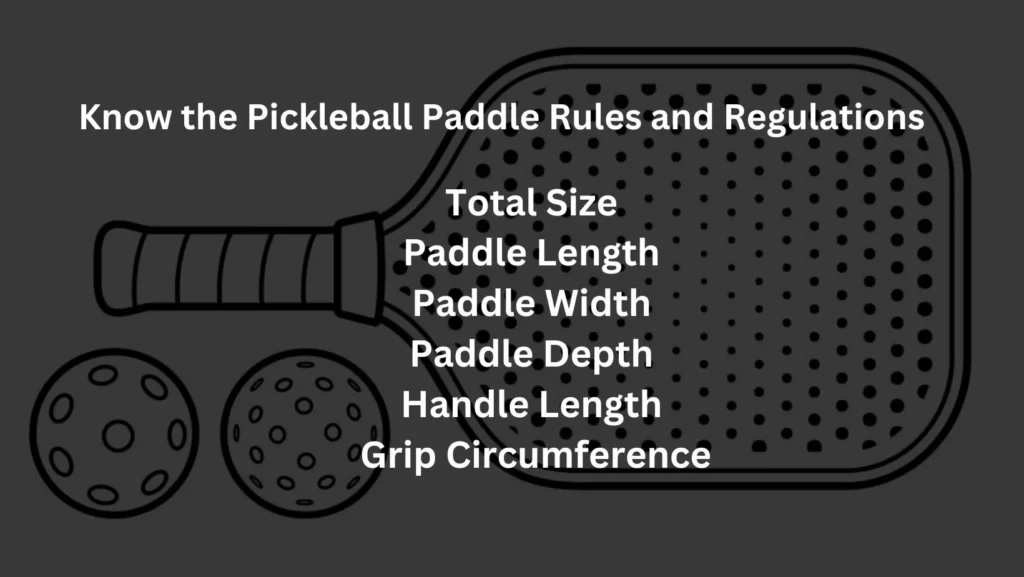
Informative Table on Pickleball Paddles Regulations
Sure, here’s an informative table that provides the rules and regulations for the size of a pickleball paddle for Better Understanding:
| Part | Size | Description |
|---|---|---|
| Total Size | ≤ 24 inches (60.96 cm) | The combined length and width, including any edge guard and butt cap, shall not exceed 24 inches |
| Paddle Length | ≤ 17 inches (43.18 cm) | The paddle length cannot exceed 17 inches |
| Paddle Width | 7 to 8.25 inches (17.78 to 20.95 cm) | The width should be within this range |
| Paddle Depth | ≥ 1.25 inches (3.175 cm) | The depth must be at least 1.25 inches |
| Handle Length | 4 to 5.5 inches | The handle of the pickleball paddle should be within this range |
| Grip Circumference | 4 to 4.5 inches (10.2 to 11.5 cm) | The grip circumference must be within this range |
Remember, these dimensions are mandatory for tournament plays. Any paddle that does not meet these requirements will not be accepted.
2.5. Decals and Alterations
The decals and alterations of the paddle are regulated by the USAPA, as they affect the appearance and integrity of the paddle. The USAPA sets the standards for the size, location, and content of the decals and alterations. To be approved by the USAPA, a paddle must meet the following requirements:
Are Decals Allowed?:
The paddle may have decals or markings on the face or the edge, as long as they do not exceed the approved dimensions of the paddle, do not cover more than 25% of the face area, and do not interfere with the hitting surface characteristics. The decals or markings must be smooth and flush with the surface of the paddle, and must not have any raised or recessed features that could affect the ball contact. The decals or markings must not have any reflective or distracting properties that could interfere with the vision of the player or the opponent.
Prohibited Alterations:
The paddle must not have any alterations that change the original shape, size, weight, or balance of the paddle, or that affect the hitting surface characteristics. The paddle must not have any alterations that are not approved by the manufacturer or the USAPA, such as drilling, cutting, bending, or adding or removing any parts. The paddle must not have any alterations that are not permanent and secure, such as stickers, magnets, or Velcro.
2.6. Why Compliance Matters
Compliance with the pickleball paddle regulations matters because it ensures the safety, fairness, and integrity of the game. Compliance with the regulations protects the players from injury, prevents unfair advantages, and preserves the spirit and tradition of the sport. Compliance with the regulations also allows the players to participate in official tournaments and events that are sanctioned by the USAPA or other governing bodies. Compliance with the regulations also shows respect and sportsmanship to the opponents and the pickleball community.
2.7. How to Choose an Approved Paddle
Choosing an approved paddle is easy, as there are many options available on the market that meet the USAPA standards and specifications. To choose an approved paddle, you can follow these steps:
- Check the USAPA Website: The USAPA website has a list of approved paddles that have passed the tests and inspections for compliance. You can search the list by brand, model, or material, and you can also see the date of approval and the expiration date of the approval. The USAPA website also has a list of non-approved paddles that have failed the tests or inspections, or that have been withdrawn or discontinued by the manufacturer. You can avoid buying or using these paddles, as they may not comply with the regulations.
- Look for the USAPA Seal: The USAPA seal is a logo that indicates that the paddle has been approved by the USAPA and meets the standards and specifications. The USAPA seal is usually printed or engraved on the face or the edge of the paddle, and it may also include the date of approval and the expiration date of the approval. You can look for the USAPA seal when buying or using a paddle, and you can also verify the authenticity of the seal by comparing it with the image on the USAPA website.
- Ask the Manufacturer or the Seller: The manufacturer or the seller of the paddle should be able to provide you with the information and the documentation about the approval status of the paddle. You can ask the manufacturer or the seller if the paddle is approved by the USAPA, and if so, when and how it was approved. You can also ask for a copy of the approval letter or certificate that confirms the approval of the paddle. You can also check the manufacturer’s or the seller’s website for the information and the documentation about the approval of the paddle.
Part 3: Exploring Pickleball Paddle Types
3.1. Standard Pickleball Paddle Shape
The standard pickleball paddle shape is the most common and popular type of paddle shape, as it offers a good balance of power and control. The standard paddle shape has a rectangular form with a width of about 8 inches and a length of about 15.5 inches, excluding the handle and the edge guard. The standard paddle shape has a large hitting surface and a large sweet spot, which makes it easier to hit the ball consistently and accurately. The standard paddle shape also has a shorter handle and a longer face, which gives it more stability and less maneuverability. The standard paddle shape is suitable for most players, especially beginners and intermediate players, who want a versatile and reliable paddle.
3.2. Elongated Pickleball Paddle Shape
The elongated pickleball paddle shape is a more specialized and advanced type of paddle shape, as it offers more reach and maneuverability, but less stability and sweet spot. The elongated paddle shape has a narrower and longer form with a width of about 7 inches and a length of about 17 inches, excluding the handle and the edge guard. The elongated paddle shape has a smaller hitting surface and a smaller sweet spot, which makes it harder to hit the ball consistently and accurately. The elongated paddle shape also has a longer handle and a shorter face, which gives it more maneuverability and less stability. The elongated paddle shape is suitable for advanced players, especially singles players, who want a fast and agile paddle.
3.3. Pickleball Paddle with a Longer Handle
The pickleball paddle with a longer handle is a rare and unique type of paddle shape, as it offers more grip options and wrist action, but less hitting surface and sweet spot. The paddle with a longer handle has a similar form to the standard paddle shape, but with a longer handle and a shorter face. The paddle with a longer handle has a smaller hitting surface and a smaller sweet spot, which makes it harder to hit the ball consistently and accurately. The paddle with a longer handle also has a longer grip and a shorter head, which gives it more grip options and wrist action, but less stability and reach. The paddle with a longer handle is suitable for players who use a two-handed backhand, or who prefer a tennis-like grip.
Also Read; Understanding Pickleball Paddle Sizes: Your Ultimate Guide
Part 4: Best Pickleball Paddles on the Market
4.1. Pickleball Paddles for Beginners
If you are a beginner pickleball player, you may want to choose a paddle that is easy to use, affordable, and durable. You may also want to choose a paddle that has a large hitting surface, a large sweet spot, and a medium weight, as these features can help you learn the basics of the game and improve your skills. Here are some of the best pickleball paddles for beginners:
Engage Pickleball Trident Pickleball Paddle:
This paddle is a great choice for beginners who want a versatile and reliable paddle. It has a standard shape, a composite face, and a polymer core, which gives it a good balance of power and control. It also has a textured surface, which helps with spin and ball placement. It weighs 7.5 to 8.0 ounces, which is a comfortable weight for most players. It has a 4.25 inch grip size, which fits most hands. It is approved by the USAPA and has the USAPA seal on the face. It costs $69.99 and comes in various colors and designs.
Franklin Signature Pickleball Paddle:
This paddle is a great choice for beginners who want a budget-friendly and durable paddle. It has a standard shape, a wood face, and a wood core, which give it a solid and sturdy feel. It also has a smooth surface, which helps with consistency and accuracy. It weighs 9.0 to 10.5 ounces, which is a heavy weight for most players, but it can also provide more power and stability. It has a 4.5-inch grip size, which fits large hands. It is approved by the USAPA and has the USAPA seal on the face. It costs $19.99 and comes in various colors and designs.
4.2. Pickleball Paddles for Advanced Players
If you are an advanced pickleball player, you may want to choose a paddle that is high-performance, high-quality, and high-tech. You may also want to choose a paddle that has a smaller hitting surface, a smaller sweet spot, and a lighter or heavier weight, depending on your playing style and preference. These features can help you enhance your game and compete at a higher level. Here are some of the best pickleball paddles for advanced players:
Engage Pickleball Pursuit Pickleball Paddles:
These paddles are great choices for advanced players who want a powerful and responsive paddle. They have an elongated shape, a composite face, and a polymer core, which give them more reach and maneuverability. They also have a textured surface, which helps with spin and ball placement. They weigh 7.5 to 8.0 ounces, which is a comfortable weight for most players. They have a 4.25-inch grip size, which fits most hands. They are approved by the USAPA and have the USAPA seal on the face. They cost $99.99 and come in various colors and designs.
Joola Ben Johns Hyperion CFS 16mm Pickleball Paddle:
This paddle is a great choice for advanced players who want a fast and precise paddle. It has a standard shape, a carbon fiber face, and a Nomex core, which give it a light and thin feel. It also has a smooth surface, which helps with consistency and accuracy. It weighs 7.0 to 7.5 ounces, which is a light weight for most players, but it can also provide more control and touch. It has a 4.25-inch grip size, which fits most hands. It is approved by the USAPA and has the USAPA seal on the face. It costs $149.95 and comes in black color.
CRBN Pickleball Paddles:
These paddles are great choices for advanced players who want a consistent and durable paddle. They have a standard shape, a carbon fiber face, and a polypropylene core, which give them a rigid and strong feel. They also have a smooth surface, which helps with consistency and accuracy. They weigh 7.8 to 8.3 ounces, which is a medium weight for most players, but it can also provide a balanced game. They have a 4.25-inch grip size, which fits most hands. They are approved by the USAPA and have the USAPA seal on the face. They cost $129.99 and come in various colors and designs.
Also Read More about CRBN at; Where are CRBN paddles Made
Selkirk Power Vanguard Air Pickleball Paddles:
These paddles are great choices for advanced players who want a versatile and innovative paddle. They have a standard shape, a carbon fiber face, and a polypropylene core, which give them a flexible and forgiving feel. They also have a textured surface, which helps with spin and ball placement. They weigh 7.4 to 7.8 ounces, which is a light weight for most players, but it can also provide more control and touch. They have a 4.25-inch grip size, which fits most hands. They are approved by the USAPA and have the USAPA seal on the face. They cost $199.99 and come in various colors and designs.
Paddletek Tempest Pro Pickleball Paddles:
These paddles are great choices for advanced players who want a balanced and reliable paddle. They have a standard shape, a graphite face, and a polypropylene core, which give them a fast and precise feel. They also have a smooth surface, which helps with consistency and accuracy. They weigh 7.6 to 8.0 ounces, which is a medium weight for most players, but it can also provide a balanced game. They have a 4.25-inch grip size, which fits most hands. They are approved by the USAPA and have the USAPA seal on the face. They cost $149.99 and come in various colors and designs.
Part 5: How to Buy the Perfect Pickleball Paddle
4 Tips for Making the Right Purchase
Buying the perfect pickleball paddle can be a challenging task, as there are many factors to consider and many options to choose from. However, you can make the right purchase by following these tips:
Know Your Skill Level and Playing Style:
Before buying a paddle, you should know your skill level and playing style, as they will determine the type of paddle that suits you best. For example, if you are a beginner, you may want a paddle that is easy to use, affordable, and durable. If you are an advanced player, you may want a paddle that is high-performance, high-quality, and high-tech. If you prefer a finesse game, you may want a paddle that is light and has more control. If you prefer a power game, you may want a paddle that is heavy and has more force.
Try Before You Buy:
The best way to find the perfect paddle is to try it before you buy it. You can try different paddles by borrowing them from your friends, renting them from your local club, or testing them at your local store. You can try different paddles by playing with them on the court, feeling them in your hand, and comparing them with each other. You can try different paddles by paying attention to their shape, weight, face material, and core, and how they affect your game. You can try different paddles until you find the one that feels comfortable, fits your hand, and matches your playing style.
Read Reviews and Ratings:
Another way to find the perfect paddle is to read reviews and ratings from other players who have used the paddle. You can read reviews and ratings from online sources, such as websites, blogs, forums, and social media. You can read reviews and ratings from offline sources, such as magazines, newspapers, and books. You can read reviews and ratings from experts, such as coaches, instructors, and professionals. You can read reviews and ratings from users, such as peers, friends, and family. You can read reviews and ratings to learn about the pros and cons of the paddle, the features and benefits of the paddle, and the experiences and opinions of the paddle.
Check the Approval Status:
The final way to find the perfect paddle is to check the approval status of the paddle. You can check the approval status by following the steps described in the previous section. You can check the approval status to ensure that the paddle complies with the official rules and regulations of pickleball, and that it is safe, fair, and legal to use. You can check the approval status to avoid buying or using a paddle that is non-approved, banned, or altered, and that could cause problems or penalties.
Conclusion
Pickleball paddle size regulations are important to understand and follow, as they ensure the safety, fairness, and integrity of the game. By complying with the regulations, you can protect yourself and your opponents from injury, prevent unfair advantages, and preserve the spirit and tradition of the sport. By complying with the regulations, you can also participate in official tournaments and events that are sanctioned by the USAPA or other governing bodies. By complying with the regulations, you can also show respect and sportsmanship to your opponents and the pickleball community. By choosing the right pickleball paddle that fits your hand, matches your playing style, and meets the standards and specifications, you can improve your gameplay and performance, and enjoy the fun and excitement of pickleball.
FAQ
Q: What are the pickleball paddle size rules in the US?
A: The pickleball paddle size rules in the US dictate the dimensions that a paddle must adhere to in order to be used in competitive play. These regulations ensure fairness and consistency in the game.
Q: What is the standard pickleball paddle size?
A: The standard pickleball paddle size is 17 inches in length and 7 inches in width. Paddles within these dimensions are commonly used by players in various skill levels.
Q: What is the maximum allowable paddle size?
A: The maximum allowable paddle size is 24 inches in length and 8 inches in width. However, it’s important to note that most players prefer paddles within the standard size range for optimal control and maneuverability.
Q: What are the legal requirements for pickleball paddle size?
A: The legal requirements for pickleball paddle size state that the paddle must not exceed the maximum dimensions of 24 inches in length and 8 inches in width. Any paddle violating these size limits may result in disqualification from sanctioned tournaments.
Q: How do I choose the appropriate pickleball paddle size?
A: When selecting the appropriate pickleball paddle size, it’s important to consider factors such as your skill level and playing style. Beginners and recreational players often benefit from using a slightly larger paddle, while advanced players may prefer a paddle closer to the standard size for increased control and precision.
Q: What are the advantages of complying with pickleball paddle size rules?
A: Complying with pickleball paddle size rules ensures fair competition, prevents accusations of cheating, and maintains the integrity of the game. Using paddles that meet the size regulations creates a level playing field and allows for a more enjoyable experience for all players involved.
